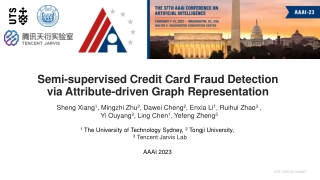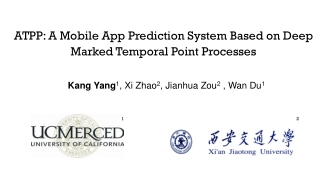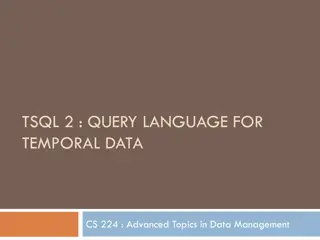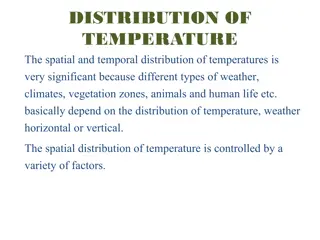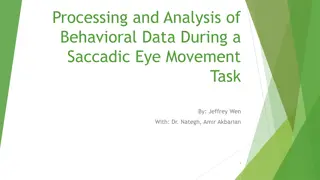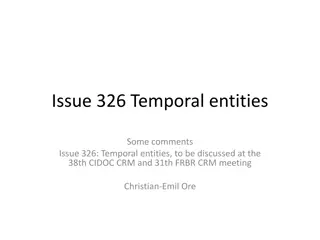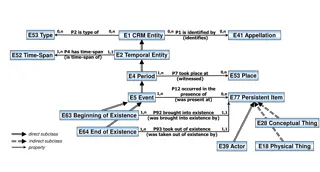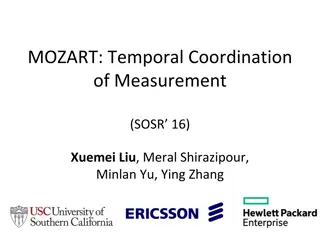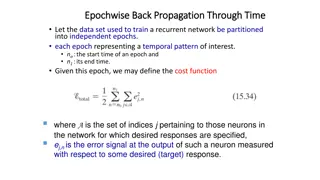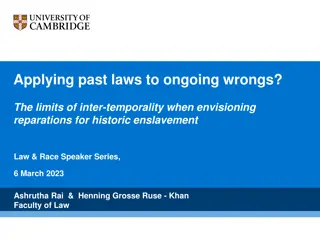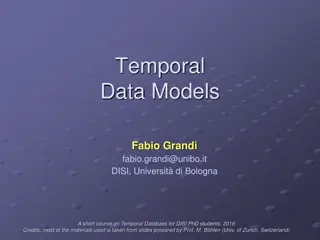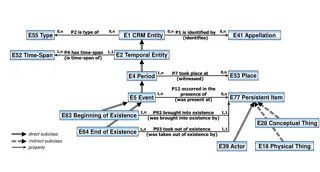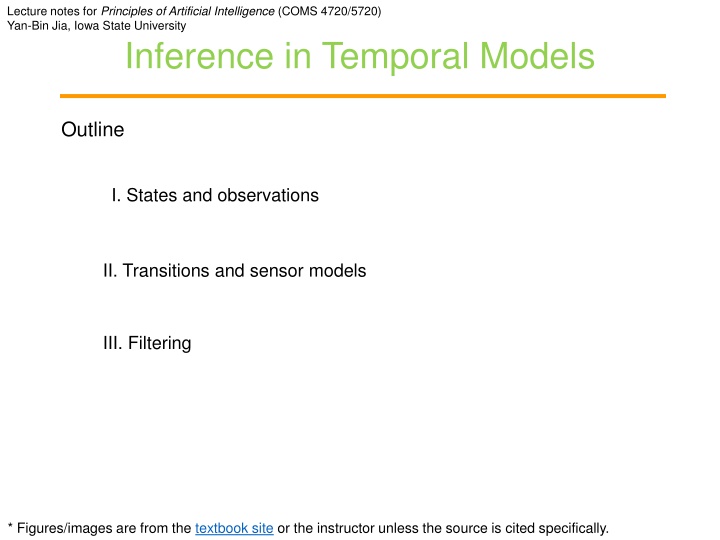
Probabilistic Reasoning in Dynamic Worlds: Inference in Temporal Models
Explore the concepts of probabilistic reasoning in dynamic environments through lecture notes covering states, observations, transitions, sensor models, filtering, discrete-time models, Markov processes, and sensor assumptions in the context of artificial intelligence principles.
Download Presentation

Please find below an Image/Link to download the presentation.
The content on the website is provided AS IS for your information and personal use only. It may not be sold, licensed, or shared on other websites without obtaining consent from the author. If you encounter any issues during the download, it is possible that the publisher has removed the file from their server.
You are allowed to download the files provided on this website for personal or commercial use, subject to the condition that they are used lawfully. All files are the property of their respective owners.
The content on the website is provided AS IS for your information and personal use only. It may not be sold, licensed, or shared on other websites without obtaining consent from the author.
E N D
Presentation Transcript
Lecture notes for Principles of Artificial Intelligence (COMS 4720/5720) Yan-Bin Jia, Iowa State University Inference in Temporal Models Outline I. States and observations II. Transitions and sensor models III. Filtering * Figures/images are from the textbook site or the instructor unless the source is cited specifically.
I. Time and Uncertainty Probabilistic reasoning in static worlds discussed so far. Every random variable has a single fixed value. Real situations are dynamic with evidence evolving with time and thus actions predicted (and chosen) based on the history of evidence: treating a patient robot localization tracking economic activities speech recognition and natural language understanding etc. How to model dynamic situations?
Discrete-Time Model The world is viewed as a series of time slices numbered 0, 1, 2, divided by the same interval . Ximea MQ022CG-CM high speed camera https://www.youtube.com/watch?v=dGBevZ54E3s Frame rate: 170 fps (frames per second) Resolution: 2048 1088 pixel Batting an in-flight dumbbell-shaped object Duration: 0.6 second with 90 frames Motion of the object estimated using an extended Kalman filter (EKF). IEEE Transactions on Robotics, vol. 38, no. 5, pp. 3187-3202, 2022. Each time slice contains a set of random variables, observable or not. ??: the set of state variables (assumed to be unobservable) at time ?. ??: the set of observable evidence variables at time ?. ??= ?? for some observed values ??
The Umbrella World ??:? denotes the state sequence ??,??+1, ,?? ??:? denotes the evidence sequence ??,??+1, ,?? The state sequence starts at ? = 0. Evidence starts at ? = 1. Example A security guard stationed underground tries to infer whether it s raining today from seeing whether others come in with or without an umbrella. For day ?: ??= Umbrella? = {??} ??= Rain? = {??} The umbrella world is represented by state variable sequence: ?0,?1,?2, evidence variable sequence: ?1,?2,?3, ?3:5 corresponds to ?3,?4,?5.
II. Transition Model Specifies the probability distribution over the latest state variables given the previous values: ? ?? ?0:? 1) Markov assumption The current state depends on only a finite fixed number of previous states. Markov chains are processes satisfying this assumption. ?th order Markov chain (or Markov process): Andrey Andreyevich Markov ? ?? ?0:? 1) = ? ?? ?? ?:? 1) 2nd order Markov process (transition model ? ?? ?? 1,?? 2)) 1st order Markov process (transition model ? ?? ?? 1)) * Photo from Wikipedia (https://en.wikipedia.org/wiki/Andrey_Markov).
Time Homogeneity & Sensor Assumptions Time-Homogeneous Process Assumption Changes in the world is governed by laws that do not change over time. E.g., in the umbrella world, ? ?? ?? 1) is the same for all ?. Sensor Markov Assumption Current sensor values are generated by the current state only. ? ?? ?0:?,?1:? 1) = ? ?? ??) sensor/observation model
Bayes Net for the Umbrella World time // ? is overloaded ??= true Transition model: ? Rain?Rain? 1) true Sensor model: ? Umbrella?Rain?) 1st order Markov Process The state (Rain) causes the sensor to take on a particular value (Umbrella).
Complete Joint Distribution Given the prior distribution ?(?0) at time 0, we have the complete joint distribution: = ? ?0 ,?1 ,?1 , ,?? ,?? ? ?0:?,?1:? = ? ?0 ? ?1 ?0)? ?1 ?1) ? ?? ?? 1)? ?? ??) ? = ? ?0 ? ?? ?? 1)? ?? ??) ?=? initial state model sensor model transition model Such a model cannot be represented by a standard Bayes net which requires a finite set of variables. Discrete time models can handle an infinite set of variables due to use of integer indices use of implicit universal quantification to define sensor and transition models
III. Filtering & Prediction Belief state: ? ?? ?1:?), the posterior distribution over the most recent state give all evidence to date. Filtering (or state estimation) is the task of computing ? ?? ?1:?). Keep track of the current state as time evolves (i.e., as ? increases). E.g., the probability of rain today, given all the umbrella observations made so far. Prediction is the task of computing ? ??+? ?1:?) for some ? > 0. Compute the posterior distribution over a future state, given all the evidence to date. E.g., the probability of rain three days from now.
Smoothing & Most Likely Explanation Smoothing is the task of computing ? ?? ?1:?) for some ?, 0 ? < ?. Compute the posterior distribution over a past state, given all the evidence to date. E.g., the probability that it rained last Wednesday. state estimate ? ?5 ?1:5) state prediction ? ?10 ?1:5) smoothed estimate ? ?1 ?1:5) time (? = 5) 1 2 3 4 5 6 7 8 9 10 Most likely explanation is the task of computing the sequence of states ?1:? to maximize ? ?1:? ?1:?). Given a sequence of observations, find the sequence of states that is mostly likely to have generated those observations. E.g., If the umbrella appears on each of the first three days and is absent on the fourth, then the most likely explanation is that it rained on the first three days and did not rain on the fourth.
Filtering To be efficient (so usable in a real time scenario), a filtering algorithm needs to maintain current state estimate and update it on the fly, and should not go back over the entire history Recursive estimation: ? ??+1 ?1:?+1) = ?(??+1,? ?? ?1:?)) state estimate at ? + 1 state estimate at ? a) Projects the current state distribution forward from ? to ? + 1. b) Updates the projected estimate using the new evidence ??+1. ? ??+1 ?1:?+1) = ? ??+1 ?1:?,??+1) = ?? ??+1 ??+1,?1:?)? ??+1 ?1:?) = ?? ??+1 ??+1)? ??+1 ?1:?) (Dividing up the evidence) (Bayes rule, given ?1:?) normalizing constant (by the sensor Markov assumption) update prediction
One-Step Prediction ? ??+1 ?1:?+1) = ?? ??+1 ??+1)? ??+1 ?1:?) = ?? ??+1 ??+1) ? ??+1 ??,?1:?)? ?? ?1:?) ?? update prediction = ?? ??+1 ??+1) ? ??+1 ??)? ?? ?1:?) ?? sensor model recursion transition model ? ??+1 ?1:?+1) = FORWARD(? ?? ?1:?),??+1) forward message ? ?0 ?1:0) = ?(?0) // Initial estimate (prior) ?(?0) ? ?1 ?1:1) ? ?? ?1:?) ? ??+1 ?1:?+1) Time and space for the update at ? must be constant in order to keep track of the current state distribution indefinitely.
Filtering in the Umbrella World Compute ? ?2 ?1:2) as follows: ?1= true ?2= true On day 0, no observation. ? ?0 = 0.5,0.5 ?0, ?0 On day 1, the umbrella appears. ?1 ?1= true a) Prediction: // ?0 ?0= true )?(?? ) ? ?1 = ? ?1 ?0 ?0 {?0, ?0} = 0.7,1 0.7 0.5 + 0.3,1 0.3 0.5 = 0.5,0.5 b) Update with evidence for ? = 1 followed by normalization: ? ?1| ?1 = ?? ?1 ?1)? ?1 = ? 0.9,0.2 0.5,0.5 = ? 0.45,0.1 0.818,0.182
Filtering in UW (contd) ? ?1 | ?1 0.818,0.182 On day 2, the umbrella appears. ?2 ?2= true // ?1 ?1= true ? ?2 ?1 )? ?1 ?1) ? ?2 | ?1 = a) Prediction: ?1 {?1, ?1} = 0.7,0.3 0.818 + 0.3,0.7 0.182 0.627,0.373 b) Update with evidence for ? = 2 : ? ?2 | ?1,?2 = ?? ?2 ?2)? ?2 | ?1 ? 0.9,0.2 0.627,0.373 ? 0.565,0.075 0.883,0.117 For Kalman filtering and its subroutine recursive least-squares (updating states out of a continuum), we refer to https://faculty.sites.iastate.edu/jia/files/inline-files/kalman-filter.pdf https://faculty.sites.iastate.edu/jia/files/inline-files/recursive-least-squares.pdf

